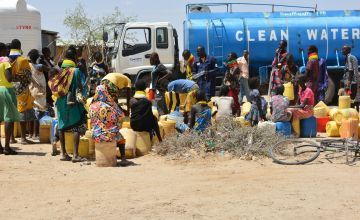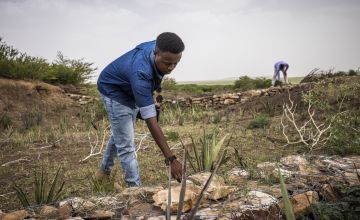
Read our 2023 annual report

Knowledge Hub
The long-awaited rains have arrived in the Horn of Africa, but the crisis is far from over

The Greater Horn of Africa is the epicentre of one of the world’s worst climate emergencies, having recently experienced one of the longest and most severe droughts on record. Yet, while rains have finally arrived, the humanitarian crisis is far from over.
Five consecutive failed rainy seasons in the Greater Horn of Africa recently resulted in the worst drought in 40 years. The drought, along with unusually high food and commodity prices and ongoing conflicts has driven record levels of humanitarian needs. Most people in the region are reliant on the land and their animals to survive. The drought destroyed their livelihoods, causing millions of people to leave their homes and villages to find food, water and pasture. Moreover, in 2022 alone, a recent UN report suggests that an estimated 43,000 people died because of the drought in Somalia, half of them most likely children under the age of five.
Close to 40 million people were still facing high levels of food insecurity in Kenya, Somalia, Ethiopia and South Sudan at the end of May 2023, with the number of internally-displaced people (IDPs) continuing to grow as the search for sources of food and water continued.
Rain does not mean relief
Whilst famine has been prevented so far, it remains a likely scenario.
Flooding
Although the much-anticipated rains have finally arrived, the humanitarian crisis is far from over. They have come in excess in some parts of the region — creating a new kind of disaster. Heavy rains have led to dangerous flash floods in some parts of Ethiopia and Somalia, as the parched ground cannot absorb water. Flash flooding also caused the banks of the Shabelle River in Somalia to break, leading to a quarter of a million people fleeing their homes.
These floods have already caused widespread damage and affected at least 900,000 people. More flooding is expected later this year, partly due to the forecasted El Niño phenomenon, potentially leading to further displacement, death and disease.

Long-term recovery
Despite the relief brought by the rains in some areas where temperatures have dropped and grazing land is regenerating, it will take years to recover from this historic drought. Most people do not have the resources to rebuild their lives and are stuck indefinitely in IDP camps, having left their homes in search of food and water. It takes a very long time for people to build back their resilience, livelihoods and assets, particularly as even if they are able to return home, they have nothing to go back to.
Solutions ranging from long-term investment in people and infrastructure to alternative ways for people to earn a living and adapt to climate change are needed. A key infrastructure we need to emphasise is the bigger run-off water harvesting dams. These are investments that have been ignored so far, but have been cited as the key source to addressing reduced rainfall and possibly the key solution missing.
Quick release and effective use of funds
In light of the glaring necessity for more funding to enable these solutions - $7 billion for humanitarian response and protection for drought and conflict-affected people in the region in 2023 – a pledging event was recently held in New York, co-hosted by the United Nations. There, $2.4 billion was announced to provide life-saving assistance for nearly 32 million people across Ethiopia, Kenya and Somalia.
These funds will allow humanitarian agencies to sustain aid pipelines of food, water, health care, nutrition and protection services. However, it does fall short of what is needed.

According to Amina Abdulla, Concern’s Regional Director for the area, it is expected that:
- It will take until 2028 of normalcy (no major shocks between now and then) for the sheep and goats herd size to return to at least 50% of their 2020 size (pre-drought).
- It will take until 2033 of normalcy (no major shocks between now and then) for the cattle and camel herd size to return to at least 50% of their 2020 size (pre-drought).
Unfortunately, for both scenarios, we anticipate at least one major shock in the next three years (flooding) and possibly drought in three to five years.
As it stands, emergency food and nutrition conditions will persist until December 2023. The recovery phase will take the best part of the next three years (on the assumption that rainfall performance will be quite normal). This will primarily focus on rebuilding lost livelihoods and supporting diversification of livelihoods for pastoralists whose livestock holding has significantly reduced over the last two and a half years.
The impact of climate change

Climate change is fuelling this erratic weather. Rainfall in the region is normally concentrated around two seasons: the long rains, which take place between March and May, and where most of the yearly rainfall occurs, and the short rains, from October to December, which are usually shorter and more variable. Climate change is affecting the rainfall periods in opposite ways. The long rains are becoming drier, with low rainfall now about twice as likely, while the short rains are becoming wetter due to climate change.
Additionally, rising temperatures, driven by climate change, have also been a major factor behind the agricultural drought, as they have significantly increased evapotranspiration, a measure of how much water can evaporate from soil and plants.
Climate injustice
Not only must the international community accept responsibility for their role in contributing to this crisis, but also it must take action to address one of the biggest climate injustices of our time.
Scientists from across the globe collaborated to assess to what extent human-induced climate change influenced the likelihood and intensity of the low rainfall that led to drought, as well as the increase in evaporation due to climate change, exacerbating drought severity. The evidence showed that without the human-driven climate crisis the world is facing today, the current historic drought that continues to fuel hunger in the Horn of Africa would have been about 100 times less likely to occur.
Moreover, the combined carbon emissions of Somalia, Ethiopia and Kenya reach a mere 0.1% of the global total, whereas the carbon emissions of the G20 countries account for 76%. In other words, people in the Horn of Africa are suffering the consequences of a climate emergency they did not create.
People will continue to face recurrent hunger crises if the countries in the region are not supported with coordinated, long-term, and augmented investments that can address immediate needs while contributing to resilience and climate adaptation.
How Concern are helping
At Concern, we are clear that the way that the world responds to climate change needs to be in line with the principles of equity and climate justice. Those countries most responsible for climate change are also most able to cover the costs of dealing with the impacts. High-income countries – like the EU, Ireland, UK and US – must provide the means of implementation to allow poorer countries to prepare for increasing climate impacts and to follow a clean, climate-friendly development pathway.
Concern is working with others to advocate for greater action on climate change, including for high-income countries to meet their commitments on climate funding for those countries suffering the impacts of climate change.
Other ways to help
Corporate support
Is your company interested in working together for a common cause?
Fundraise for Concern
From mountain trekking to marathon running, cake sales to table quizzes, there are lots of ways you can support our work.
Buy a gift
With an extensive range of alternative gifts, we have something to suit everybody.
Leave a gift in your will
Leave the world a better place with a life-changing legacy.
Volunteer with Concern
The lots of ways to get involved with our work as a volunteer
School fundraising
Without the generous support from schools, we wouldn't be able to do the work that we do.




